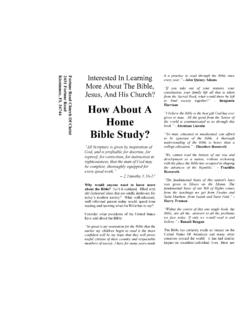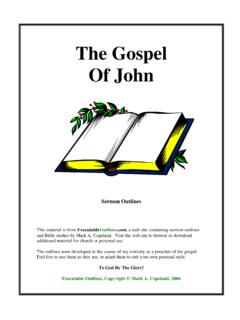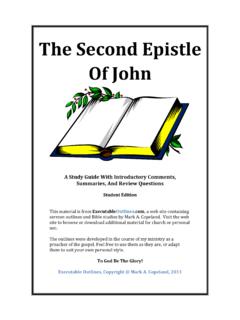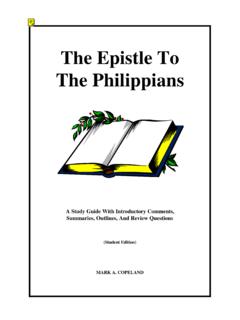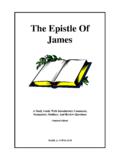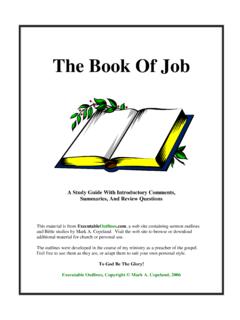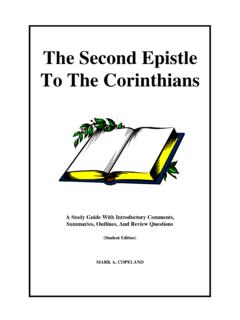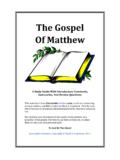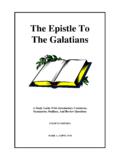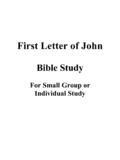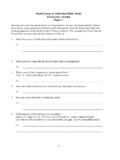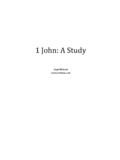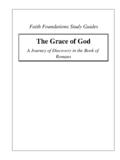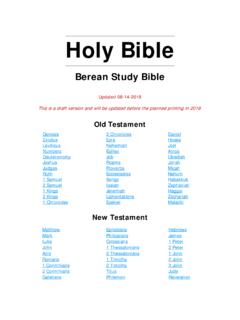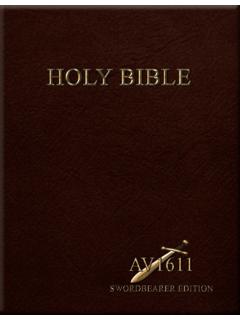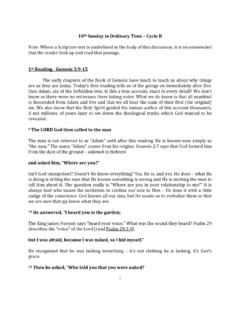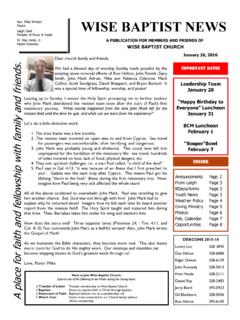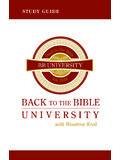Transcription of The$First$Epistle$ OfJohn$ - Executable Outlines
1 The first Epistle Of John A Study Guide With Introductory Comments, Summaries, And Review Questions Student Edition This material is from , a web site containing sermon Outlines and Bible studies by Mark A. Copeland. Visit the web site to browse or download additional material for church or personal use. The Outlines were developed in the course of my ministry as a preacher of the gospel. Feel free to use them as they are, or adapt them to suit your own personal style. To God Be The Glory! Executable Outlines , Copyright Mark A. Copeland, 2011 2 The first Epistle Of John Table Of Contents Introduction 3 Chapter One 6 Chapter Two 7 Chapter Three 8 Chapter Four 9 Chapter Five 10 This study guide was designed for adult Bible classes, though it might be suitable for junior and senior high classes as well.
2 Some have used it for personal devotions, and others in small study groups. In whatever way it can be used to the glory of God, I am grateful. Points to ponder for each chapter are things I emphasize during the class. Review questions are intended to reinforce key thoughts in each chapter. There is a teacher s edition available with answers included. 3 The first Epistle Of John Introduction When Jesus to earth, He came not only to live a life, but to give life: I have come that they may have life, and that they may have it more abundantly. - Jn 10:10 The Gospel of John was designed to produce faith so that we might have life (Jn 20:30- 31).
3 However, it is The first Epistle of John which describes the nature of that life in greater detail ( , 1Jn 3:14). That we might be sure to live the sort of life God offers through His Son Jesus Christ, a careful study of The first Epistle Of John is in order. Author It is assumed in this study that the author is John, the beloved disciple of Jesus (Jn 13:23; 19:26- 27; 20:2; 21:7,20). Similarities in style, vocabulary, and themes in both this epistle and the Gospel of John certainly offer internal evidence for this conclusion. There is also external evidence that John is the author. Polycarp, a close associate of John, appears to make reference to this epistle in a letter to the Philippians at the beginning of the second century.
4 Irenaeus, a student of Polycarp, quoted from the epistle and attributed it to John. Recipients No one is specifically mentioned by name. John may have been in Ephesus at the time, and some think this was a general epistle to Christians throughout Asia Minor (modern day Turkey). Comments in 1Jn 2:20,27 could imply that John was addressing a specific group of Christians that possessed certain spiritual (miraculous) gifts. Date Estimates range from 60 to 100 Most modern scholarship places it around 95 , but there are also good reasons for believing it was written prior to the destruction of Jerusalem in 70 (Re- dating The New Testament, John A.)
5 T. Robinson). Purpose And Theme In his epistle John frequently states why he was writing: these things we write to you that your joy may be full - 1Jn 1:4 these things I write to you, that you may not sin - 1Jn 2:1 these things I have written to you may know that you have eternal life - 1Jn 5:13 these things I have written to you may continue to believe in the name of the Son of God" - 1Jn 5:13 While these reasons may state the positive purpose for John's letter, it appears he was also responding to errors prevalent at the time ( these things I have written to you concerning 4 those who try to deceive you - 1Jn 2:26).
6 If not fully developed in John s day, there was at least a precursor to Gnosticism. Those who later came to be called Gnostics claimed to have a superior knowledge (the Greek word for knowledge is gnosis). A fundamental presupposition was that all matter was evil. Therefore they believed that God did not create or have anything to do with the material universe (rather, it was created by a demi- god). Also, that Christ could not have come in the flesh (cf. 1Jn 4:1- 3). One branch of Gnosticism, Docetism (dokein, to seem ), taught that Jesus only seemed to be physical (contrast that with John s statement in 1Jn 1:1).
7 Cerinthus, a contemporary of John, taught that Jesus was physical, but that the "Christ" came upon Him at his baptism, and then left before His death, so that the "Christ- spirit" never suffered (cf. 1Jn 5:6). The Gnostics application to everyday living took two different directions. Since all matter was considered evil, some taught one should abstain altogether from anything that would satisfy the flesh. Others claimed it did not matter what one did in the flesh (it was evil anyway), and to have full knowledge it was proper to explore everything. John s purpose therefore appears to be two- fold: Assure Christians that they have eternal life (1Jn 5:13) Counter those who denied that Jesus had come in the flesh (1Jn 4:1- 6) As the theme of this epistle, may I suggest: Eternal life is in Jesus Christ, who has come in the flesh outline Here is an outline of the book, from the Holman Illustrated Bible Prologue: The Word of Life (1:1- 4) 1.
8 God Is Light (1:5 3:10) a. Walk in the Light (1:5 2:2) 1) God is Light (1:5- 7) 2) Resist sin (1:8 2:2) b. Obey the command to love (2:3- 11) 1) Know God and keep His commands (2:3- 6) 2) Learn the new command and love others (2:7- 11) c. Know your spiritual status (2:12- 14) d. Be warned of enemies of the faith (2:15- 27) 1) Beware of the world (2:15- 17) 2) Beware of the antichrists (2:18- 27) e. Live like children of God (2:28 3:10) 1) Be confident and ready for His coming (2:28 3:3) 2) Be righteous and do not sin (3:4- 10) 2. God Is Love (3:11 5:12) a.
9 Love one another: part one (3:11- 24) 1) Love in action (3:11- 18) 2) Live in confidence (3:19- 24) b. Test the spirits (4:1- 6) 5 c. Love one another: part two (4:7- 21) 1) Love others because God loves you (4:7- 10) 2) Love others because God lives in you (4:11- 21) d. Obey God and experience the victory of faith (5:1- 5) e. Believe in the Son and enjoy eternal life (5:6- 12) Conclusion: Confidence and Characteristics of the Child of God (5:13- 21) a. Know you have eternal life (5:13) b. Be confident in prayer (5:14- 17) c. Do not continue in sin (5:18- 20) d.
10 Keep yourself from idols (5:21) Review Questions 1) Who is author of The first Epistle Of John? 2) Who were the original recipients of this epistle? 3) When was it written? 4) List four reasons John stated for writing this epistle. (1:4; 2:1; 5:13) 5) List another reason John wrote this epistle. (2:26) 6) What doctrine later found in Gnosticism is addressed in this epistle? 7) What has been suggested as its two- fold purpose? 8) What has been suggested as its theme? 9) What are the main divisions of this epistle as outlined above? 6 The first Epistle Of John Chapter One John begins his first epistle like he does his gospel: with a prologue regarding the Word of Life (Jesus Christ) who dwelt in the flesh among men and made fellowship with the Father possible (1- 4).
